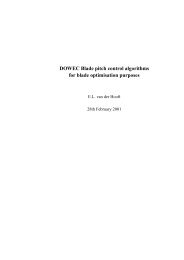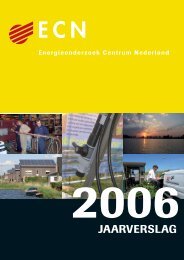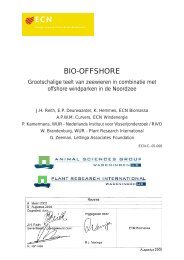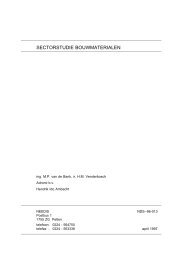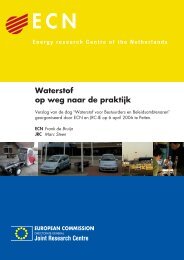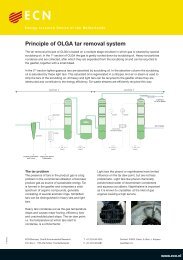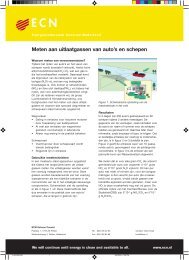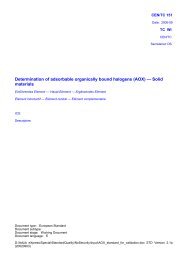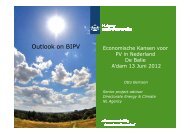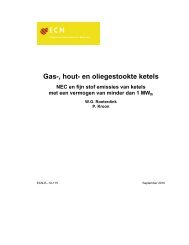PDF format (503 kB) - ECN
PDF format (503 kB) - ECN
PDF format (503 kB) - ECN
You also want an ePaper? Increase the reach of your titles
YUMPU automatically turns print PDFs into web optimized ePapers that Google loves.
aluminium may allow production of high quality scrap based aluminium, be it with probably higher specific<br />
emissions than those of current secondary production.<br />
Conclusions<br />
The results clearly indicate that, even with high emission factors for electricity, the factor 2 and even the factor<br />
10 emission reductions are readily attainable in the steel sector, when CO2 removal is applied. In this case,<br />
changes in the ratio between primary and scrap based production are not necessary; in some scenarios, some<br />
primary production routes have even lower emissions than scrap based production routes. It is also important to<br />
note that for the realisation of the factor 10 emission reduction, it is not necessary to call for processes that are<br />
still in an experimental stage.<br />
The reduction potential of primary aluminium production lags somewhat behind, but with a low emission factor<br />
for electricity, a factor 8 reduction is possible, by a shift to the new bipolar electrode process. A moderate<br />
increase of recycling would further decrease the emissions of aluminium production. If this would not be possible,<br />
extra reductions in the steel sector could compensate.<br />
The influence of external factors, especially that of the possibilities for CO2 removal, is strong, not only on the<br />
total emissions reduction potential, but also on the choice of the production route. The choice for the best production<br />
route requires extensive knowledge of the developments outside the base metal sector.<br />
Because of this sensitivity of the results for developments outside the sector, and the fact that CO2 removal is<br />
imperative for attainment of the factor 10 reduction in primary steel, it is advisable to investigate the possibilities<br />
for increasing scrap based production. If a shift to secondary production is possible, the reduction potentials<br />
for steel, and especially aluminium, further increase.<br />
Two developments, mainly driven by forces outside the (primary and secondary) metal sector may further influence<br />
the sector thoroughly, namely dematerialisation and the implementation of integral cycle management.<br />
Both trends may substantially decrease the demand for primary produced (ferrous) materials and may also decrease<br />
the related CO2 emissions.<br />
Dematerialisation consists out of several phenomena, such as miniaturisation, substitution by light-weight materials,<br />
resulting in a net decrease of the material intensity of the Gross Domestic Product. Especially the ferrous<br />
metals production sector has already been affected by the dematerialisation trend. Therefore, the growth<br />
rates in this sector have been lower than the GDP growth rates. A high dematerialisation trend in the future<br />
may even stop the growth in the ferrous metals production sector, while it may favour the aluminium and plastic<br />
production sectors.<br />
Integral cycle management aims at the closing of material cycles in the society and the prevention of material<br />
losses. This strategy consists out of society measures to increase the quality of materials derived from post consumption<br />
waste and industry measures to increase the content of secondary materials in the production sectors.<br />
Examples are design-to-dismantle and design-for-recycle practices in industry, standardisation of materials for<br />
specific applications, separate collection and treatment of usable products, parts and other material streams. A<br />
systematic approach can result in an optimal material cascade that saves more than 50% of the primary inputs<br />
and decreases the energy requirements for materials with a similar percentage without compromising the quality<br />
of materials and products [19].<br />
List of abbreviations<br />
ACEAF Alternating Current Electric Arc Furnace<br />
BF150 air Blast Furnace, 150 kg/tonne coal injection<br />
BF250 oxygen Blast Furnace, 250 kg/tonne coal injection<br />
BOF Basic Oxygen Furnace<br />
CCF Cyclone Converter Furnace<br />
Cir Circofer



